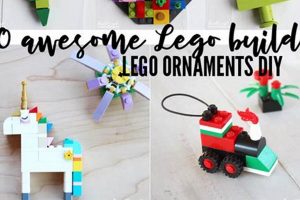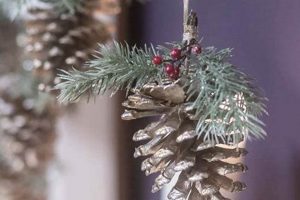The creation of festive decorations from timber using individual craftsmanship represents a popular holiday activity. These handcrafted items provide a personal alternative to mass-produced decorations, offering a tangible expression of creativity. Examples include painted wooden shapes, intricately carved designs, and ornaments constructed from reclaimed wood.
The appeal of constructing personalized holiday decorations stems from several factors. This activity offers a cost-effective way to adorn homes, repurposes materials, and provides a meaningful family experience. Historically, handmade decorations reflect a connection to tradition, contrasting with commercially available options. The resulting ornaments often become cherished keepsakes, imbued with sentimental value.
The following sections will detail specific techniques, readily available materials, and innovative design ideas to facilitate the construction of unique and personalized embellishments for the holiday season.
Guidance for Wooden Holiday Embellishment Creation
The following recommendations are intended to enhance the quality and longevity of handmade decorations fashioned from timber.
Tip 1: Material Selection: Employ seasoned wood to minimize warping and cracking. Kiln-dried lumber represents a stable choice for detailed projects.
Tip 2: Design Planning: Prioritize a well-defined plan. Sketch designs and templates to ensure accurate execution and minimize material waste.
Tip 3: Precision Cutting: Utilize appropriate cutting tools. A scroll saw or coping saw provides accuracy for intricate designs. Ensure blades are sharp for clean cuts.
Tip 4: Surface Preparation: Sand surfaces thoroughly. Progress through increasingly finer grits of sandpaper to achieve a smooth finish. This enhances paint adhesion and aesthetic appeal.
Tip 5: Finishing Techniques: Apply appropriate finishes. Acrylic paints, stains, and varnishes provide protection and aesthetic enhancement. Multiple thin coats yield better results than a single thick coat.
Tip 6: Secure Assembly: Employ robust adhesives. Wood glue or epoxy resin ensures components remain securely joined. Clamping during the drying process strengthens bonds.
Tip 7: Protective Coating: Apply a sealant. Polyurethane or lacquer protects against moisture and wear, extending the lifespan of the decoration.
Tip 8: Safe Storage: Store ornaments carefully. Wrap fragile pieces individually to prevent breakage and damage during the off-season.
Adherence to these recommendations facilitates the creation of durable and visually appealing decorations, ensuring their enjoyment for years to come.
The subsequent section will examine specific design inspirations and project ideas for handcrafted holiday decorations.
1. Wood Selection
The selection of timber is a foundational decision in the creation of wooden holiday decorations. The characteristics of the chosen wood directly influence the ease of fabrication, the aesthetic qualities of the finished product, and its long-term durability. Therefore, understanding the properties of various wood types is crucial for successful ornament creation. Softwoods, such as pine and fir, are relatively easy to cut and shape, making them suitable for simpler designs. However, they are more susceptible to damage and may not hold fine details as effectively. Conversely, hardwoods like oak and maple offer greater strength and can support intricate carving, but require more effort and specialized tools to work. The decision should align with the planned design and available resources.
Consider, for instance, a project involving delicate fretwork. A hardwood, despite its greater initial challenge, would be the superior choice due to its ability to maintain structural integrity and prevent breakage in thin sections. Alternatively, for a simple, painted design, pine provides an economical and workable solution. The presence of knots and grain patterns also presents a factor. Clear, consistent grain is preferable for painting, while unique knot patterns might be incorporated intentionally into the design of rustic-style ornaments. In practice, a lack of consideration for these properties can lead to structural failure, difficulty in achieving the desired aesthetic, or a significantly shortened lifespan for the ornament.
In summary, appropriate material selection underpins every successful attempt to construct wooden holiday decorations. The choice of wood dictates the achievable level of detail, influences the required skillset and tools, and affects the final ornament’s longevity. By understanding these fundamental relationships, creators can make informed decisions that maximize the aesthetic appeal and durability of their finished projects, enhancing the overall quality and enjoyment of holiday decorations.
2. Design Complexity
The level of intricacy incorporated into wooden holiday decorations directly influences the required skill, the time investment, and the ultimate visual impact. Design complexity, therefore, represents a critical consideration in the planning and execution of timber-based festive embellishments.
- Level of Detail
Design complexity often manifests in the fineness of details incorporated into the ornament. Simple designs may feature basic shapes and broad strokes, while complex designs involve intricate carvings, minute embellishments, and the precise layering of various wooden components. The ability to execute these details effectively hinges on the creator’s skill and the availability of suitable tools.
- Number of Components
The overall design can grow in complexity when the project involves numerous distinct components, each needing precise cutting, shaping, and assembly. Complex designs commonly involve multiple layers, articulated parts, or intricate joinery. Managing these individual parts requires careful planning and meticulous execution to ensure a cohesive and structurally sound final product.
- Techniques Employed
The complexity of a design is also determined by the techniques utilized in its creation. Straightforward projects may require simple sawing, sanding, and painting. In contrast, advanced designs might call for wood carving, wood burning, intricate joinery, and the application of specialized finishing techniques. Each technique adds to the overall complexity, requiring a greater depth of skill and knowledge.
- Material Variety
Designs may range from single-wood projects to more elaborate ventures, incorporating diverse materials and embellishments. These may consist of combining different types of wood to enhance textural qualities, inlaid materials like metal or glass, and external decorations like beads, ribbons or paint. Incorporating such elements requires adept planning and execution to harmonize different materials into a visually appealing whole.
These facets of design complexity are interrelated and critical to the successful fabrication of wooden holiday decorations. A higher degree of complexity typically demands more advanced skills, specialized tools, and a more significant time investment. The careful consideration of these factors ensures that the chosen design aligns with the creator’s capabilities and resources, ultimately contributing to a satisfying and visually appealing outcome.
3. Cutting Precision
In the context of crafting wooden holiday decorations, cutting precision directly affects the quality and appearance of the final product. Inaccurate cuts result in misaligned pieces, gaps in joints, and a general lack of refinement, detracting from the overall aesthetic. The causal relationship is clear: heightened cutting accuracy produces elevated visual appeal and structural integrity. For instance, creating a wooden snowflake ornament requires exact symmetry and sharp points; deviations compromise its recognizable form. Similarly, interlocking pieces for a three-dimensional star must fit together seamlessly; inaccuracies create a structurally weak and visually unappealing outcome. Cutting precision is therefore not merely a desirable attribute, but a fundamental requirement for achieving professional-quality results.
The practical significance of understanding this relationship extends to the choice of tools and techniques. A scroll saw, for instance, offers greater control for intricate cuts compared to a jigsaw. Using sharp blades and maintaining a steady hand are essential for minimizing splintering and ensuring clean edges. Templates and guides can further enhance accuracy by providing a physical reference. A common challenge encountered by novice creators involves imprecise mitering, leading to gaps at corners. This can be addressed by using a miter saw with adjustable angles or by carefully sanding the edges to achieve a precise fit. These practical considerations transform a theoretical understanding of cutting precision into actionable steps, improving the likelihood of success. Consider the fabrication of a complex jigsaw-style ornament. Each piece must interlock perfectly; otherwise, the entire design will fail. Precise cutting is thus critical for realizing the intended outcome.
In summary, cutting precision is inextricably linked to the successful creation of wooden holiday decorations. Its impact extends beyond mere aesthetics, influencing structural integrity and the overall impression of craftsmanship. Adopting suitable tools, mastering proper techniques, and understanding the practical implications of accuracy are paramount. While challenges exist, a focus on cutting precision elevates the quality and value of handcrafted festive embellishments, transforming them into cherished heirlooms.
4. Finishing Quality
The application of a suitable finish to handcrafted wooden holiday decorations extends beyond mere aesthetics; it serves as a critical determinant of the ornament’s longevity, durability, and overall value. Finishing quality, therefore, represents a central consideration in the creation of these decorative items.
- Surface Preparation
Prior to the application of any finish, meticulous surface preparation is essential. Sanding, filling imperfections, and ensuring a clean, smooth substrate are crucial steps. Failure to adequately prepare the surface results in uneven finish application, highlighting imperfections and compromising the final appearance. For example, residual sawdust trapped within the wood grain will interfere with paint adhesion, leading to premature chipping and an uneven texture.
- Type of Finish
The selection of an appropriate finish is predicated on both aesthetic considerations and functional requirements. Paints, varnishes, lacquers, and stains offer differing levels of protection against moisture, UV radiation, and physical abrasion. A high-gloss varnish, while providing a durable and reflective surface, may not be suitable for ornaments intended to possess a rustic, matte aesthetic. Conversely, a water-based stain, while environmentally friendly, may not offer sufficient protection for ornaments exposed to humid environments.
- Application Technique
Proper application techniques are essential for achieving a uniform and durable finish. The use of appropriate brushes, spray equipment, or wiping cloths, combined with correct layering and drying times, ensures optimal results. Brush strokes, uneven spraying, or premature handling can mar the finish, compromising its protective qualities and aesthetic appeal. Multiple thin coats, properly dried between applications, typically yield a superior result compared to a single, thick coat.
- Protective Properties
A well-applied finish protects the wooden ornament from environmental degradation, extending its lifespan and preserving its appearance. Finishes act as a barrier against moisture absorption, preventing warping, cracking, and fungal growth. UV-resistant finishes prevent fading and discoloration caused by sunlight exposure. Durable finishes withstand handling and abrasion, minimizing scratches and damage from everyday use. For example, an ornament coated with polyurethane is significantly more resistant to scratches and moisture damage compared to an unfinished piece.
The aspects of finishing quality detailed above demonstrate the critical role finishing plays in the creation of handcrafted wooden holiday decorations. From the initial preparation of the wood’s surface to the selection and application of the final coating, each step directly influences the aesthetic appeal, durability, and longevity of the finished ornament. A thoughtful approach to finishing ensures that these decorative items become cherished keepsakes, enjoyed for years to come.
5. Assembly Integrity
The construction of wooden holiday decorations relies fundamentally on the structural soundness of the assembled components. Assembly integrity, therefore, dictates the long-term viability and aesthetic preservation of these handcrafted items. Compromised assembly jeopardizes both the ornament’s structural integrity and its overall presentation.
- Adhesive Selection
The choice of adhesive directly influences the strength and durability of bonded joints. Wood glue, epoxy, and cyanoacrylate offer varying properties regarding bond strength, drying time, and gap-filling capabilities. Using an inappropriate adhesive can result in joint failure under stress or environmental changes. For instance, polyvinyl acetate (PVA) glue, while suitable for many woodworking tasks, may not withstand prolonged exposure to humidity, potentially causing delamination of ornament components.
- Joint Design
The design of joints significantly impacts the overall strength of the assembled structure. Mortise and tenon joints, dovetail joints, and lap joints offer superior mechanical strength compared to simple butt joints. Employing a butt joint without reinforcement for load-bearing components can lead to premature failure. The incorporation of well-designed joinery distributes stress more effectively, ensuring greater structural stability. The selection and preparation of parts for the assembly, it must be fit properly to avoid any problem when applying any adhesive on the parts.
- Clamping Techniques
Effective clamping is essential during the adhesive curing process. Applying consistent pressure ensures proper contact between mating surfaces, maximizing bond strength. Insufficient clamping pressure can result in weak or incomplete bonds, compromising the structural integrity. Furthermore, uneven clamping pressure can cause misalignment of components, affecting the aesthetic appearance of the finished ornament.
- Material Compatibility
The compatibility of different materials used in the assembly influences the long-term stability of the ornament. Combining dissimilar materials with significantly different expansion and contraction rates can create stress within the joints, leading to cracking or delamination. For example, attaching metal embellishments to wood without accounting for their differing thermal expansion coefficients can result in joint failure over time. Consideration must be given to the materials being assembled to mitigate potential structural compromises. The assembly process must be aligned with parts that has the characteristic from material compatibility.
These facets of assembly integrity, including adhesive selection, joint design, clamping techniques, and material compatibility, collectively determine the structural stability and longevity of handcrafted wooden holiday decorations. Attention to these details during the assembly process ensures that these items withstand the test of time, preserving their aesthetic appeal and sentimental value.
6. Durability Enhancement
The long-term preservation of handcrafted wooden holiday decorations necessitates proactive measures to enhance their resistance to degradation. Durability enhancement, therefore, becomes a critical objective in the creation of these items, directly influencing their longevity and continued aesthetic appeal.
- Protective Coatings Application
The application of protective coatings, such as varnishes, lacquers, or polyurethane, forms a primary defense against environmental factors. These coatings create a barrier against moisture, ultraviolet radiation, and physical abrasion. For instance, an ornament treated with a UV-resistant varnish will resist fading and discoloration when exposed to sunlight, unlike an unfinished piece. The specific choice of coating should align with the intended use and environmental conditions to which the ornament will be exposed.
- Wood Stabilization Techniques
Wood stabilization aims to reduce the wood’s tendency to expand, contract, or warp due to changes in humidity and temperature. Kiln-drying the wood prior to construction minimizes internal stresses and reduces moisture content. Applying wood stabilizers, such as penetrating epoxy sealers, further reduces moisture absorption. Consider, for example, a wooden ornament displayed in a humid bathroom; without stabilization, it is prone to warping and cracking.
- Joint Reinforcement Methods
Reinforcing joints strengthens the structural integrity of the ornament, preventing breakage and separation of components. Methods include the use of robust joinery techniques (e.g., mortise and tenon, dovetail), the incorporation of metal fasteners (e.g., screws, nails), and the application of high-strength adhesives. For a delicate ornament with multiple small pieces, reinforcing the joints is crucial to prevent separation during handling or storage.
- Appropriate Material Selection
The inherent durability of the selected wood species contributes significantly to the ornament’s overall lifespan. Hardwoods, such as oak or maple, offer greater resistance to physical damage compared to softwoods, such as pine or fir. Selecting a wood species appropriate for the intended use and anticipated handling intensity is critical. An ornament intended for frequent handling by young children, for example, would benefit from the selection of a more durable hardwood.
These facets of durability enhancement directly affect the long-term viability of handcrafted wooden holiday decorations. Applying protective coatings, stabilizing the wood, reinforcing joints, and selecting appropriate materials contribute to the creation of ornaments that withstand the rigors of repeated use and environmental exposure. Implementing these measures transforms these decorative items into lasting keepsakes, capable of being cherished across generations. The integration of these practices is crucial for artisans aiming to create high-quality, enduring decorations.
Frequently Asked Questions about Wooden Holiday Decoration Crafting
The following section addresses common inquiries regarding the creation of wooden holiday embellishments, providing clarity on key aspects of material selection, construction techniques, and long-term preservation.
Question 1: What wood types are most suitable for creating durable holiday decorations?
Hardwoods such as oak, maple, and walnut offer superior durability for wooden holiday ornaments. These species resist dents, scratches, and warping better than softwoods. The selection should align with the intended complexity of the design, as hardwoods require more specialized tools and techniques to manipulate effectively.
Question 2: How can designs be transferred accurately onto wooden ornament blanks?
Several methods facilitate accurate design transfer, the method should align with your skill. Transfer paper, templates, and projection techniques can be employed. The chosen method should ensure precise duplication of the design onto the wood surface, minimizing errors that could affect the final product’s quality. Consider carefully the chosen procedure for its potential to impact the project outcome.
Question 3: What safety precautions should be observed when using power tools for woodworking?
Eye protection, respiratory masks, and hearing protection are essential when operating power tools. Ensure adequate ventilation to prevent the inhalation of dust and fumes. Maintain a clean and organized workspace to minimize tripping hazards. Proper training and adherence to manufacturer guidelines are critical for safe and effective tool operation.
Question 4: How can a professional-looking finish be achieved on a wooden ornament?
Achieving a professional finish necessitates careful surface preparation, including thorough sanding to progressively finer grits. Apply multiple thin coats of finish, allowing adequate drying time between each application. Consider using a spray gun for even and consistent coverage. The selection of a high-quality finish product significantly impacts the final result.
Question 5: What are the recommended methods for preventing wood from warping or cracking?
Employ kiln-dried wood to minimize internal stresses and reduce moisture content. Apply wood stabilizers or sealers to further reduce moisture absorption. Avoid exposing finished ornaments to extreme temperature or humidity fluctuations. Proper storage, away from direct sunlight and sources of heat, prolongs the ornament’s lifespan.
Question 6: How can personalized embellishments be added to handcrafted wooden decorations?
Personalization can be achieved through various techniques, including painting, carving, wood burning, and the incorporation of decorative elements such as beads, ribbons, or glitter. Consider the aesthetic compatibility of these embellishments with the overall design. Ensure that any added materials are securely attached to prevent detachment or damage.
These frequently asked questions address common challenges and concerns encountered during the creation of wooden holiday decorations. Adhering to these guidelines promotes successful project outcomes and ensures the longevity of handcrafted festive items.
The subsequent section will provide a compilation of innovative project ideas and creative design inspirations for wooden holiday embellishments.
Conclusion
The preceding exploration has elucidated the multifaceted aspects of festive decorations crafted from timber using individual craftsmanship. Key points encompassed material selection, design complexity, cutting precision, finishing quality, assembly integrity, and durability enhancement. Each element exerts a discernible influence on the aesthetic appeal and longevity of these handcrafted embellishments, rendering them enduring symbols of holiday tradition.
Continued refinement of techniques and thoughtful application of principles outlined herein ensure the sustained relevance and value of individualized, handcrafted festive adornments. A renewed appreciation for the art and tradition of wooden ornament creation will invariably enrich the holiday experience for both creator and recipient, thereby preserving a tangible manifestation of seasonal spirit for generations to come.







